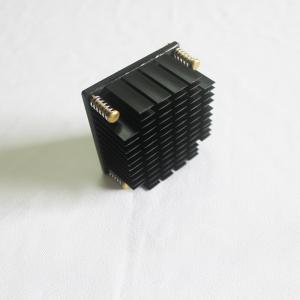

Add to Cart
Forged Heatsink For Camera Cooling Accessories With CNC Machining Process
| Raw Material | AL1070/1060/copper |
| Custom Service | Yes, OEM/ODM Service |
| Quality System | ISO9001:2015 |
| Processing Technology | Forged/cutting/laser/CNC/Anodizing |
| Surface treatment | Anodizing free style color |
| Packing Way | Blister packaging or special packing you would like |
| Application Scenario | Electronic equipment heat sink |
| MOQ Request | 100/500/1000 |
Description
Cold forged heat sinks are ideal for casting complex shapes with
excellent thermal conductivity. The cold forging process can
achieve almost perfect straightness, with more heat sinks per
square millimeter. The shape of cold forging pin fin heat sink
includes plate-fin heat sink, round pin heat sink and oval fin heat
sink. The manufacture of forged heat sinks is very suitable for the
use of copper, because copper heat sinks can be formed without high
temperature and can cause minimal damage. The manufacture of cold
forged heat sinks can usually include secondary machining
operations, such as holes, chamfering, and steps to reduce
unnecessary waste.
Heat sink manufacturers have widely used cold forging technology in
the production of light source heat sinks and LED heat sinks.
Winshare is one of the few companies that used cold forging to
produce heat sinks in the early days. We have accumulated rich
experience in cold forging technology. In addition to producing
heat sinks for typical light sources, Winshare has also gained
experience in manufacturing high-power cold forged heat sinks. We
have solved problems such as the low thermal conductivity of
die-cast microchannels and the higher cost of processing
microchannels. We have applied cold forging heat sinks to cooling
solutions, including high-voltage inverters, wind power converters
and motor controllers.
A Forged heatsink is manufactured using a modification of this
process called cold forging. Cold forging uses high pressure and
low temperature to ensure that no air bubbles, or other impurities
are trapped in the material. This improves the thermal properties
of the heatsink, and increases the density of the material.
A Forged heatsink is manufactured using a modification of this
process called cold forging. Cold forging uses high pressure and
low temperature to ensure that no air bubbles, or other impurities
are trapped in the material. This improves the thermal properties
of the heatsink, and increases the density of the material. Radian
Thermal Products utilizes special open die tooling and intense
pressure to produces high precision heatsinks with high aspect
ratios. A Forged heatsink is typically manufactured one part at a
time, and can be can be made from AL 6063 or C1100. Aspect ratio up
to 35:1 are feasible, and no draft angles required on fins. Fins
can be round, elliptical, straight or any combination on the same
part.
The cold forging process is to forge the product at room
temperature. The product has high shape and dimensional accuracy,
good internal density, high strength of the workpiece, smooth
surface, few processing procedures, and is convenient for mass
production.
Cold forged heat sinks are widely used for heat dissipation of LED
lamps. The shapes of cold forged heat sink include plate pin fin
heat sinks, round pin heatsinks and oval fin heat sinks. Using cold
forging heatsink will reduce the overall weight and volume of LED
lamps to achieve The purpose of reducing the overall cost is to
make the product more competitive!
The cold forged heat sink is widely used in the heat dissipation of
LED lamps and has the following advantages:
(1) The price of cold forging die is not high, which can
effectively control the cost;
(2) High production capacity, suitable for mass production;
(3) The mold production cycle is relatively short, usually 10 to 15
days;
(4) One-time molding, the heat dissipation performance of cold
forging heatsink is consistent with the heat dissipation
performance of the material, and the post-processing procedures are
few and simple.
(5)The major advantages of cold forging are close dimensional
tolerances, good surface finish quality, and the use of lower cost
materials to obtain the required strength by work hardening without
requiring heat treatment.
Cold forged heat sink
An added benefit of this process is that a forged heatsink of the
same design can be manufactured with different heights using only
one set of forging die. When working with high aspect ratio, or
dense fins a forged heatsink has no thermal interface between the
fins/pins, and the base which will provide better performance
compared with stamped-fin or bonded-fin heat sinks. Heat
distribution can be further improved in aluminum heatsinks by
embedding a copper inserts into the base during the forging. As
this process is fairly expensive, for small volumes it may be worth
exploring extrusion with a cross cut to produce square pins. For
larger volumes die cast is a good alternative.
Fodor has gained experiences in the manufacturing techniques for
high power cold forged heat sink. We have resolved the problems
such as the low thermal conductivity of die-casting micro-channels
and higher costs for machining micro-channels. We have already
applied cold forging heatsink to cooling solutions including
high-voltage inverters, wind power converters, and electric motor
controllers.
1. Manufactoring process: Cold forging process
2. Material: AL1070
3. Surface treatment: Clear/black/red/gold anodizing
4. Product type: Customized Design
5. Packing: export standard carton box with pallet.
6. Application: Industry/medical/measurement/house
you have any inquiry, please contact us.
